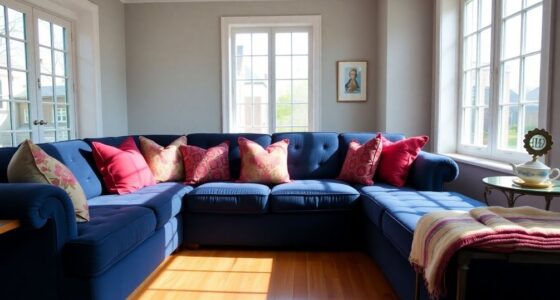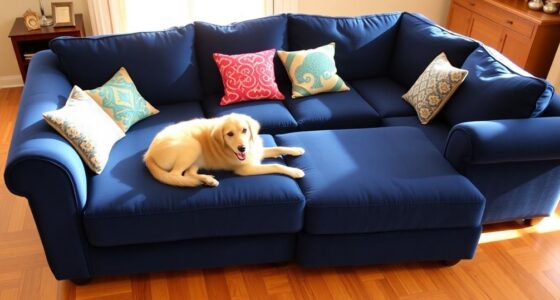To achieve harmonious furniture placement, you need to focus on balance, flow, and functionality. Start by arranging your pieces to create natural pathways, ideally maintaining at least 3 feet of space for movement. Consider your furniture's scale; avoid overcrowding and distribute heavier items evenly for visual stability. Incorporate varied seating options and define conversation areas with group shapes like U or L formations. Pay attention to colors that influence mood and use negative space to enhance relaxation. By following these strategies, you'll create inviting spaces that feel right. There's plenty more to explore to optimize your setup!
Key Takeaways
- Prioritize natural movement flow by maintaining clear pathways of at least 3 feet wide to ensure accessibility and ease of movement.
- Create balance and symmetry by distributing heavier furniture evenly and using pairs of décor items to enhance visual stability.
- Choose a cohesive colour scheme that reflects the desired mood, utilizing cool hues for calmness and warm hues for energy.
- Establish functional conversation areas with U-shape or L-shape seating arrangements, allowing for face-to-face interaction and effective communication.
- Regularly assess and rearrange furniture to maintain a harmonious atmosphere, avoiding overcrowding and ensuring all pathways remain unobstructed.
The Science of Furniture Arrangement

When you arrange furniture, you're not just filling a space; you're shaping the atmosphere and functionality of your home. Thoughtful furniture placement can create a harmonious living space that encourages interaction and conversation.
Start by considering the room's size and layout, ensuring natural movement flow without obstacles. Position larger pieces around focal points like fireplaces or windows to enhance visual interest.
Distributing heavy and light furniture creates a balanced space, preventing a lopsided appearance. Also, remember to create adequate negative space around your furniture; this fosters relaxation and openness.
Achieving Balance and Symmetry

To create a serene and organized space, achieving balance and symmetry in your furniture arrangement is crucial.
Start by distributing heavier pieces evenly across the room to avoid a lopsided look and promote a cohesive look. Use pairs of furniture and décor items, like matching lamps or side tables, to reinforce symmetry and visual stability.
Arrange your furniture around a central focal point, such as a fireplace or artwork, to create a structured and inviting environment. Incorporating a mix of furniture sizes and shapes not only contributes to visual interest but also guarantees each piece serves a functional purpose. This careful consideration of balance and symmetry enhances visual harmony, resulting in a calming atmosphere you'll enjoy every day. Additionally, utilizing natural materials in your decor can further enhance the overall aesthetic and warmth of the space.
Psychological Impact of Colour

When you choose colours for your space, you're not just picking a shade; you're setting the mood.
Cool hues can create a serene atmosphere, while warm tones inject energy and vibrancy into the room.
Understanding how colour psychology works can help you design a space that truly reflects your emotional needs.
Colour Psychology Overview
Understanding how colour influences your emotions can transform your living space into a sanctuary of well-being.
Colour psychology shows that your choice of hues can greatly affect the mood and atmosphere. For instance, cool tones like blues and greens promote calmness, while warm colours such as reds and yellows evoke energy.
By creating cohesive colour schemes, you encourage unity within a room, enhancing its visual appeal. Accent colours, introduced through accessories like cushions or artwork, add depth, making your space inviting and aesthetically pleasing.
The psychological advantages of strategic colour choices can improve overall well-being; studies even suggest that blue can lower heart rates, making it perfect for relaxation spaces. Additionally, incorporating effective relaxation techniques can further enhance the calming effects of your colour choices.
Embrace colour to foster emotional responses that enhance your daily life.
Creating Mood With Colour
Selecting the right colours for your space can greatly affect the mood you want to create. Your colour selection influences how each furniture piece contributes to the room's emotional response.
Cool hues like blues and greens promote calmness, while warm hues such as reds and yellows evoke energy. By employing cohesive colour schemes, you establish a sense of unity, while complementary colours boost visual appeal.
Introduce accent colours through accessories to add depth and personality, enhancing the atmosphere. Understanding colour psychology is essential in interior design, as it can greatly improve your well-being and emotional responses to the space. Additionally, incorporating aesthetic hooks can enhance vertical space while complementing your colour choices, creating both functionality and style.
Thoughtful colour choices transform a room, making it not just visually appealing but also emotionally resonant.
Incorporating Negative Space

Incorporating negative space into your furniture arrangement creates an inviting atmosphere that feels open and balanced. This concept refers to the areas around and between furniture pieces, essential for a sense of openness. When you allow for adequate negative space, it fosters relaxation and enhances overall aesthetics. Additionally, understanding effective preparation for your space can significantly improve the outcome of your furniture placement.
Here's how to contemplate negative space in your placement:
| Aspect | Importance | Tips |
|---|---|---|
| Define Areas | Creates distinct zones | Use rugs or plants |
| Visual Appeal | Highlights key furniture items | Balanced distribution |
| Traffic Flow | Enhances movement throughout space | Guarantee pathways are clear |
| Harmonious Relationship | Maintains balance | Avoid overcrowding |
| Accessories | Complement negative space | Choose wisely to enhance focus |
Tips for Harmonious Spaces

Creating harmonious spaces involves more than just arranging furniture; it's about fostering an environment that feels balanced and inviting.
To achieve this, focus on furniture placement that facilitates a smooth flow of movement, maintaining walkways of about 3 feet. Create conversation areas by positioning sofas and armchairs face-to-face within 8-10 feet of each other for easy interaction.
Remember to avoid overcrowding by incorporating negative space, allowing for breathing room between pieces. Use focal points, like windows or artwork, to guide your arrangements while enhancing visual interest. Additionally, consider the importance of standard dining table height to ensure comfort and functionality in your space.
Balance heavier furniture with lighter pieces throughout the room to achieve balance and harmony, ensuring your space feels open, inviting, and comfortable for everyone.
Importance of Focal Points

While a room can be beautifully decorated, it often lacks a sense of purpose without a clear focal point. Focal points, like fireplaces or large windows, serve as visual anchors around which you can arrange your furniture placement.
By positioning your seating to face these elements, you'll encourage conversation and create inviting spaces for social interaction. This enhances not just the aesthetics of the room but also its functionality.
Make sure your focal point is easily visible from various seating areas to establish a cohesive look. Additionally, using accessories like artwork can further enhance this area, drawing attention while ensuring a harmonious balance in traffic flow and overall design.
Creating Conversation Areas

Establishing conversation areas in a room can transform it into a welcoming space that encourages interaction. To create harmonious seating arrangements, consider the following:
| Arrangement Type | Benefits |
|---|---|
| U-shape | Promotes face-to-face conversation, enhancing intimacy. |
| L-shape | Maintains closeness while allowing for flexible seating. |
| Central Table | Anchors the area, providing a functional surface for drinks and decor. |
Remember to arrange your furniture about 8-10 feet apart for effective communication while keeping the atmosphere cozy. Incorporate various seating options, like armchairs and benches, to cater to different group sizes. Adjust your arrangements based on the room's usage and dynamics, ensuring flexibility for various gatherings and activities.
Traffic Flow Considerations

When arranging your furniture, keeping clear pathways of at least 3 feet wide is essential for smooth movement.
You don't want to obstruct doorways or high-traffic areas, as that can disrupt the flow and make the space feel cramped.
Clear Pathways Importance
Creating clear pathways in your living space is vital for both comfort and safety. Aim for pathways about 3 feet wide to guarantee comfortable movement and accessibility, preventing congestion.
Unobstructed entryways and major traffic routes are significant, especially in high-traffic areas, allowing swift movement during emergencies or daily activities. Avoid bulky furniture that can disrupt flow, and consider using furniture groupings to create natural changes within the space.
Rugs can also help guide movement while keeping an open feel. Regularly assess your pathways after arranging furniture to verify they promote ease of movement. Additionally, incorporating ergonomic furniture can enhance comfort and reduce strain during long hours spent in your space.
Avoid Obstruction Areas
While clear pathways lay the groundwork for a functional space, avoiding obstruction areas is just as important for maintaining smooth traffic flow.
When arranging your furniture, make sure to avoid blocking doorways, allowing easy access and enhancing safety. Maintain walkways of at least 3 feet in width, ensuring there's enough space for comfortable movement.
Aim for 18 to 24 inches between seating arrangements to create a sense of openness and accessibility. By properly spacing furniture pieces, you'll not only facilitate movement but also contribute to creating a harmonious environment.
After you've finished your furniture placement, assess the layout to confirm that all pathways are clear, promoting a seamless shift between different areas of your space.
Comfortable Movement Space
To guarantee a comfortable movement space, it's essential to prioritize traffic flow throughout the room. Aim for walkways of about 3 feet in width to secure accessibility and smooth navigation.
Keep unobstructed entryways and major traffic routes clear to prevent congestion, making changes between areas seamless. Avoid placing bulky furniture in high-traffic spots; this promotes flow and minimizes the risk of accidents.
Focus on creating natural changes, allowing for intuitive movement that enhances the room's functionality. Regularly assess pathways after furniture placement to verify all areas remain accessible, confirming your layout truly supports its intended use.
Common Mistakes in Arrangement

When arranging furniture, many people overlook common mistakes that can drastically affect a room's feel and functionality.
Here are four key errors to avoid:
- Pushing furniture against walls: This can disrupt the flow of the room, making it feel isolated and uninviting.
- Ignoring the scale of furniture: Using pieces that don't fit the room's dimensions can lead to overcrowding or wasted space.
- Blocking light sources: Obstructing windows or lamps results in a dim atmosphere, diminishing the room's appeal.
- Prioritizing aesthetics over functionality: This often leads to impractical arrangements that hinder daily activities. Additionally, utilizing vertical storage solutions can enhance both organization and space efficiency in your room.
Room-by-Room Strategies

When arranging your living room, think about how you'll create inviting conversation areas around a focal point.
In the bedroom, placing your bed against a solid wall can enhance balance while ensuring easy access.
Finally, for your dining space, center the table to promote flow and comfort during meals.
Living Room Layout
Creating an inviting living room layout starts with arranging your seating around a central focal point, like a fireplace or television, which encourages conversation among guests.
To create a harmonious atmosphere, follow these tips:
- Design conversation zones: Position chairs and sofas in U-shape or L-shape layouts for intimate interactions.
- Ensure a clear walkway: Maintain about 3 feet between furniture pieces to facilitate comfortable movement.
- Mix furniture sizes: Use a variety of shapes to create visual interest, ensuring larger pieces aren't pushed against the walls.
- Incorporate multifunctional furniture: Choose items like ottomans or coffee tables with storage to maximize usability and keep your living room clutter-free.
These strategies will enhance your living room's inviting atmosphere.
Bedroom Arrangement Tips
A well-arranged bedroom can greatly enhance your comfort and promote restful sleep. Follow these bedroom arrangement tips to achieve a soothing and functional space:
| Tip | Description |
|---|---|
| Bed Placement | Position your bed against a solid wall for a sense of security. Avoid placing it under a window. |
| Nightstands | Incorporate bedside tables on both sides to create balance and symmetry. |
| Pathways | Maintain clear pathways of at least 2-3 feet around the bed for easy movement. |
| Color & Lighting | Use soothing colors like light blues or greens, and guarantee adequate lighting for a cozy ambiance. |
Additionally, consider incorporating cat furniture to create a harmonious living environment if you have pets that might disrupt the space.
Dining Space Design
Designing a dining space that feels inviting and functional can greatly enhance your mealtime experience. Here are four strategies to create a harmonious dining area:
- Position your dining table centrally for easy access and flow, allowing room for chairs to pull out comfortably.
- Maintain at least 36 inches of clearance between the table and walls or furniture to facilitate movement.
- Opt for a round or oval table to foster intimacy and encourage conversation, especially in smaller spaces.
- Incorporate a sideboard for additional storage and serving space, ensuring it complements the table's height.
Finally, enhance the ambiance with appropriate lighting, like a pendant or chandelier, positioned 30-36 inches above the dining table for ideal illumination.
Frequently Asked Questions
What Is the 2/3 Rule for Furniture?
The 2/3 rule for furniture placement suggests that you should fill about two-thirds of a room's area with furniture, leaving one-third open for space.
This balance enhances flow and accessibility, making your room feel inviting and comfortable. By following this rule, you'll guarantee that pathways are clear and furniture pieces are proportional to the room size, helping you create a harmonious environment that highlights focal points while avoiding overcrowding.
What Is the Biggest Mistake in Placement of Furniture?
Have you ever noticed how pushing all your furniture against the walls can make a room feel disconnected? One of the biggest mistakes in furniture placement is exactly that.
It limits conversation flow and creates an uninviting atmosphere. Instead, try arranging your furniture to foster interaction and maintain balance.
Is There an Optimal Way to Arrange My Living Room Furniture for Airflow?
Yes, there's definitely a preferable way to arrange your living room furniture for airflow.
Start by ensuring clear pathways of at least 3 feet wide, allowing for comfortable movement.
Position larger pieces away from walls to create breathing room and avoid blocking vents or windows.
Incorporate negative space by placing furniture at varying distances, and use lighter materials to enhance that airy, open feel.
This'll promote better airflow and a more inviting atmosphere.
How Should the Furniture Be Arranged?
To arrange your furniture effectively, start by identifying the room's main purpose and a focal point, like a fireplace or window.
Position seating to foster conversation, keeping sofas and chairs within 8-10 feet apart. Make sure to leave clear pathways of about 3 feet for easy movement, avoiding blockages near doorways.
Mix larger and smaller pieces to balance visual weight, and regularly adjust the layout to fit your changing needs or preferences.
Conclusion
In furniture placement, remember that "less is more." By embracing balance, color psychology, and negative space, you can transform any room into a harmonious haven. Keep in mind the flow of traffic and create inviting conversation areas to enhance your space's functionality. Avoid common pitfalls, and tailor your arrangement to each room's unique needs. With these strategies, you'll not only elevate your living environment but also enjoy a peaceful, inviting atmosphere that truly feels like home.









